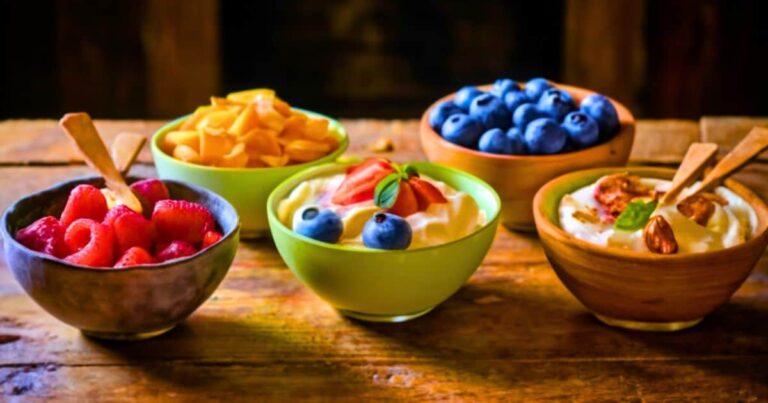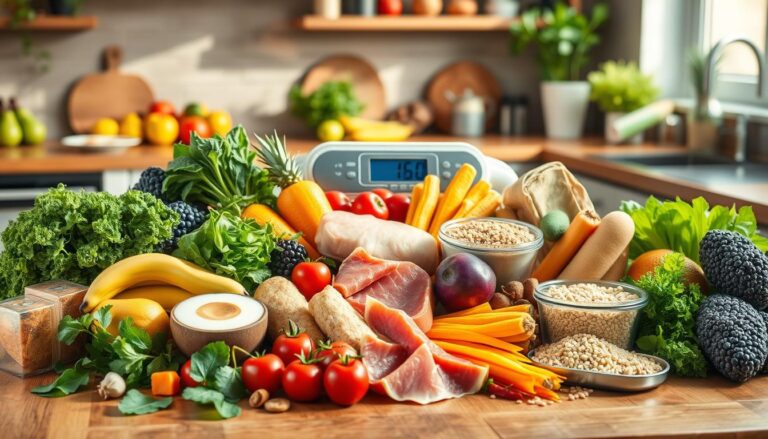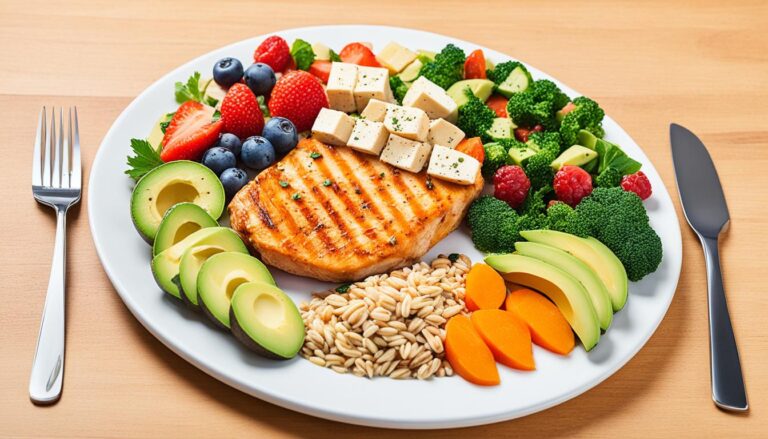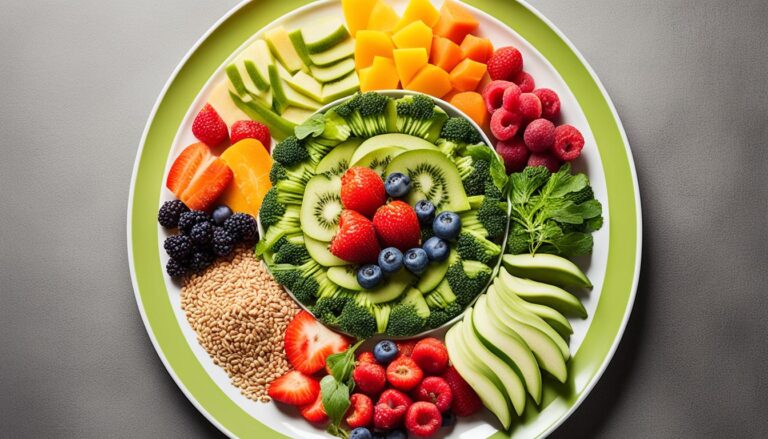Can the foods you eat speed up your body’s calorie burn? Find out about the metabolism-boosting foods list backed by science. Metabolism, the energy source for every cell, slows down with age and genetics. But, research shows certain foods like protein, spicy ingredients, and specific nutrients can help.
These 13 foods boost your metabolism in different ways. For example, green tea, protein, and MCTs in oils all help. While no single food guarantees quick results, a balanced diet with these foods can improve your metabolism over time.
Key Takeaways
- Drinking cold water burns 8 extra calories per glass as the body warms it.
- Lentils reduce calorie intake and waist measurements in clinical studies.
- Green tea’s catechol-O-methyltransferase inhibition boosts fat oxidation.
- MCTs increase fat burning rates during exercise compared to long-chain fats.
- Cinnamon doses of 2g daily for 12 weeks reduce fat mass and waist circumference.
- Dark chocolate (30g daily for four weeks) lowers BMI in 35-study reviews.
Understanding Your Metabolism and Why It Matters
Metabolism is how our body turns food into energy. It keeps us alive by powering breathing and organ work. Knowing about metabolism helps us see how foods that increase metabolism and lifestyle choices affect our energy levels.
What Exactly Is Metabolism?
Our basal metabolic rate (BMR) is 60–75% of our daily calorie use. It changes based on who we are. The thermic effect of food (TEF) also matters, with protein meals needing more energy to digest than fats or carbs.
Muscle mass is key, as it burns more calories at rest than fat does.
The Role of Metabolism in Weight Management
Metabolism works with diet and exercise to control weight. While what foods boost metabolism can help burn calories, keeping weight off needs a balance of intake and expenditure. Eating more protein, for instance, helps keep muscle mass when we eat less calories.
Exercise and NEAT (non-exercise activity thermogenesis) also add to our daily energy use.
Factors That Influence Your Metabolic Rate
- Age: Metabolic rate drops 5% every decade after 40 because of muscle loss.
- Body Composition: Muscle burns 3–5x more calories at rest than fat does.
- Genetics: Some people are born with a higher BMR, but lifestyle can help.
- Hydration: Drinking 500ml of water can make metabolism 10–30% higher through thermogenesis.
These factors show why we need to tailor our diet and exercise to our own needs. By matching our choices to our metabolism, we can improve our health.
The Science Behind Food and Metabolic Rate
Understanding how foods affect our metabolism starts with the thermic effect of food (TEF). This is the energy our body uses to digest and absorb nutrients. foods to speed up metabolism often focus on macronutrients with high TEF values, like proteins. These require more energy to digest than fats or carbs.

natural metabolism boosters like protein-rich foods can raise your metabolic rate by 15–30%. This is because proteins are more complex to digest. Carbs increase it by 5–10%, while fats barely do anything, at 0–3%. This shows how what we eat affects how much energy we burn each day. Here’s a look at how different nutrients affect TEF:
| Nutrient | TEF Energy Expenditure |
|---|---|
| Protein | 10–30% of energy content |
| Carbohydrates | 5–10% of energy content |
| Fats | 0–3% of energy content |
Bioactive compounds in foods also matter. Capsaicin in chili peppers and EGCG in green tea boost thermogenesis, burning calories. A 2021 study found that diets with 40% protein increased calorie burning by 80–100 calories. Ginger supplements also raised TEF by 43 calories daily.
When we eat also affects our metabolism. Eating during active times matches our body’s natural rhythms, improving how we use nutrients. For instance, eating protein after working out helps repair muscles and burns more energy. Studies suggest this can increase our resting metabolic rate by 5% over time.
What Foods Boost Metabolism? The Scientific Evidence
Studies show that what foods boost metabolism can help with metabolic function. But, their effects are small and work best with a healthy lifestyle. Here’s what the science says:
- Protein-rich foods like eggs and lean meats need more energy to digest. This can increase your metabolic rate by 15–30% during digestion.
- Caffeine in coffee or tea may raise metabolism by 3–4% temporarily. Green tea’s antioxidants also help a bit.
- Fiber-rich foods (e.g., veggies, whole grains) slow digestion, keeping your metabolism going. Eating lots of fiber is linked to better metabolic health.
| Food Category | Metabolic Mechanism | Evidence Strength |
|---|---|---|
| Protein | Thermic effect of food (TEF) | Strong |
| Caffeine | Adrenaline-induced fat burning | Moderate |
| Fiber | Prolonged digestion and satiety | Moderate |
Experts say foods that help boost metabolism should be part of a bigger plan. This includes exercise, staying hydrated, and getting enough sleep. For example, the Mediterranean diet, rich in plants and healthy fats, is good for your metabolism over time.
No single food can change your metabolism a lot. But, eating well and staying active together can make a big difference. Always focus on eating a balanced diet, not just looking for “superfoods.”
Spicy Superstars: How Chili Peppers and Spices Fire Up Your Metabolism

Chili peppers and spices do more than add flavor. They boost your metabolism naturally. Capsaicin, the heat source, makes your body burn more calories. It can increase calorie burning by 8–10% and help burn fat.
A Purdue University study found that even small doses of cayenne pepper (0.3g) reduced hunger and increased energy expenditure in participants.
Capsaicin: The Compound Behind the Burn
Capsaicin in chili peppers makes your body warmer. This can improve how your body handles fats. Eating a jalapeño can help burn calories for hours.
Best Spices to Include in Your Metabolism-Boosting Diet
| Spice | Key Compound | Metabolic Benefits |
|---|---|---|
| Chili Peppers | Capsaicin | Thermogenesis, appetite suppression |
| Ginger | Gingerol | Promotes calorie burning, aids digestion |
| Turmeric | Curcumin | Supports fat metabolism, reduces inflammation |
| Black Pepper | Piperine | Enhances nutrient absorption, boosts metabolism |
Easy Ways to Add More Spice to Your Meals
- Season soups and stews with red pepper flakes or cayenne.
- Mix chili powder into Greek yogurt or hummus dips.
- Grind fresh ginger into smoothies bases for a thermogenic boost.
- Blend turmeric and black pepper into scrambled eggs or roasted vegetables.
These natural metabolism boosters make meals more exciting without extra calories. Adding them to your diet helps keep your metabolism going and supports a healthy weight.
Protein-Rich Foods That Increase Metabolism
Protein-rich foods are great for boosting your metabolism. They make your body burn more calories when you digest them. This is because protein needs more energy to break down than carbs or fats.
Studies show that eating more protein can increase your metabolic rate. This helps with weight control and keeping muscles strong.
Protein has a higher thermic effect than carbs or fats. This means it helps keep your metabolism higher even when you’re not active. For example, a 2020 review found that high-protein diets can increase daily energy use by up to 891 kJ.
Here are some key protein sources and their benefits:
| Food Source | Protein Content | Metabolic Benefits |
|---|---|---|
| Eggs | 6.29g per large egg | High-quality protein; supports muscle repair and TEF |
| Salmom | 22g per 3-ounce serving | Omega-3 fatty acids + sustained metabolic activation |
| Greek Yogurt | 17g per 6-ounce serving | Enhances satiety and muscle maintenance |
| Legumes | 18g per 1-cup serving | Plant-based protein with fiber; linked to reduced metabolic syndrome risk |
Here are some tips:
- Eat 25–35% of your daily calories as protein for better TEF
- Choose lean meats, fish, and plant-based options like lentils or tempeh
- Aim for 1.6g/kg body weight during weight loss to preserve muscle mass
The National Institutes of Health say adults should eat at least 46g (females) or 56g (males) of protein daily. For best results, eat protein-rich foods with water and do regular strength training. These foods help keep your metabolism healthy and support your weight loss goals.
Green Tea and Coffee: Caffeine’s Effect on Metabolic Function
Green tea and coffee are great for boosting your metabolism. They have caffeine and other compounds that help your body burn more calories. Drinking them can increase your metabolic rate by 3-11%, helping you burn calories even when you’re not active.

How Caffeine Stimulates Calorie Burning
Caffeine makes your body release adrenaline. This tells fat cells to use stored fat for energy. People who drink coffee regularly lose more body fat than those who don’t.
A 2020 study found that drinking green tea extract can help you lose weight. Caffeine also helps you burn more fat during exercise.
Optimal Consumption Times for Maximum Benefit
When you drink caffeinated drinks matters. Drinking them 30-60 minutes before working out can help you burn more fat. If you don’t exercise, drinking it throughout the day helps avoid getting too used to it.
The FDA says to limit caffeine to 200-400 mg a day. This is about 2-4 cups of coffee.
Other Beneficial Compounds in These Beverages
- Green tea has EGCG, which works with caffeine to increase fat burning.
- Coffee has chlorogenic acid, which helps slow down how quickly carbs are absorbed.
- Oolong and matcha green tea have more catechins, making them better for burning fat.
A 2023 study found that drinking green tea can help you lose 4.4% of your waist size. Coffee’s chlorogenic acid helps control blood sugar after meals. But, how much you benefit can depend on your body size and how much caffeine you drink.
When picking foods to boost your metabolism, choose unsweetened options. Drinking these beverages with exercise can help you burn more calories without too much caffeine.
Metabolism-Boosting Fruits and Berries
Nature offers many metabolism-boosting foods list items that help keep your metabolism healthy. Berries and citrus fruits are full of fiber, antioxidants, and compounds that help digestion, reduce inflammation, and burn calories. These foods that help boost metabolism are low in calories but high in energy and metabolic efficiency.
- Blueberries: High in polyphenols that improve fat metabolism and reduce oxidative stress.
- Strawberries: Contain ellagic acid, which may regulate blood sugar levels and reduce insulin spikes.
- Grapefruit: Contains naringingin, linked to reduced markers of metabolic syndrome.
- Apples: Rich in pectin fiber, which helps you feel full and supports gut health.
- Pineapple: Bromelain enzyme aids protein digestion and inflammation reduction.
| Fruit | Key Nutrients | Metabolic Benefits |
|---|---|---|
| Blueberries | Polyphenols, vitamin C | Enhances fat oxidation and supports cardiovascular health. |
| Raspberries | Fiber, ellagic acid | Stabilizes blood sugar and promotes gut microbiome balance. |
| Citrus (lemons/oranges) | Flavonoids, vitamin C | Supports insulin sensitivity and reduce inflammation. |
| Pineapple | Bromelain, manganese | Improves protein digestion and metabolic efficiency. |
“Grapefruit preloads can reduce energy intake and improve metabolic markers in individuals with obesity,” noted researchers in a 2011 clinical trial.
Add berries to yogurt, smoothies, or salads for a fiber-rich boost. Frozen berries are just as nutritious, making them great all year. Eat citrus fruits with meals to help your body absorb nutrients better. Choose whole fruits over juices to keep fiber and natural sugars intact. These foods, along with protein-rich foods, help create a balanced diet that boosts your metabolism.
The Power of Whole Grains and Complex Carbohydrates
Whole grains are key for a metabolism-boosting diet. They give you lasting energy and help your metabolism. Foods like oats, quinoa, and brown rice have fiber that slows down sugar absorption. This keeps your energy steady and boosts your metabolism.

Fiber in whole grains affects your metabolic rate. Soluble fiber, like beta-glucan in oats, helps bind cholesterol and slow digestion. Insoluble fiber keeps your gut healthy, supporting your metabolism. Studies show eating whole grains can lower your risk of death by 22% and heart disease by 30%.
The 2015-2020 Dietary Guidelines suggest eating at least 3 ounces of whole grains every day.
- Oats: Rich in beta-glucan, oatmeal stabilizes blood sugar and aids weight management.
- Quinoa: A complete protein, quinoa supports muscle maintenance while regulating metabolism.
- Brown Rice: High in magnesium, it aids insulin sensitivity and energy production.
- Barley: Contains beta-glucan fiber that improves satiety and reduces cholesterol absorption.
- Buckwheat: Gluten-free and nutrient-dense, it contains rutin, which enhances vascular health.
Start by swapping refined grains for whole ones. Try overnight oats or whole-grain salads in your meals. The American Heart Association says eating whole grains can lower heart disease risks. Adding protein to your meals with whole grains can also lower diabetes risk by 21%.
Follow USDA guidelines for fiber intake: 25-30g daily. Focus on complex carbs over simple sugars. This diet reduces inflammation and keeps your energy steady. Choose unprocessed options like steel-cut oats or farro to get the most nutrients and benefits.
Healthy Fats That Help, Not Hinder, Your Metabolism
Not all fats slow down your metabolism. Some fats, like omega-3s and medium-chain triglycerides (MCTs), actually help it. These top metabolism-boosting foods boost energy, reduce inflammation, and improve how your body handles sugar. This makes them part of a science-backed metabolism-boosting diet.
Omega-3 Fats and Metabolic Efficiency
Omega-3 fatty acids are found in fatty fish like salmon and in plants like flaxseeds. They help your body burn fat better and increase your resting metabolic rate. A 2023 study showed they also help build lean muscle, which burns more calories than fat.
Plant-Based vs. Animal Sources
| Source Type | Examples | Key Benefits |
|---|---|---|
| Plant-Based | Coconut oil, avocados, walnuts | MCTs in coconut oil boost energy expenditure. Avocados provide monounsaturated fats that aid nutrient absorption. |
| Animal-Based | Fatty fish (salmon, mackerel), eggs | Omega-3s in fish support cellular function and reduce metabolic inflammation. |
Use these fats wisely: use coconut oil in small amounts for cooking, and add nuts to meals for longer feeling full. But remember, fats are high in calories, so don’t overdo it.
- Add chia seeds to smoothies for omega-3s and fiber
- Choose wild-caught salmon twice weekly for optimal EPA/DHA intake
- Replace butter with avocado slices on toast to enhance meal quality
It’s all about balance. Choose unprocessed fats and eat them with protein-rich foods. This way, these fats fuel your cells and help your metabolism in the long run.
Water and Hydration: The Forgotten Metabolism Enhancer
Water is essential for our metabolism, acting as a zero-calorie natural metabolism booster. Drinking foods to speed up metabolism is important, but so is staying hydrated. Studies reveal drinking two cups of water can increase metabolic rate by 24–30% for 40–90 minutes.

A 2013 study found overweight girls who drank 500ml of water before meals lost 5 pounds more fat than a control group over 12 weeks.
Hydration aids in metabolic processes like nutrient transport and waste elimination. Dehydration can slow down metabolism by reducing cellular hydration levels. Drinking 500ml of water can burn 25 extra calories in 90 minutes, leading to 10 pounds lost over a year.
- Drink 2 cups of water 10–15 minutes before meals to boost metabolism and reduce appetite
- Track intake using the 3L daily guideline (about 13 cups) adjusted for activity levels
- Incorporate water-rich foods like cucumbers (96% water, 18 calories/cup) and watermelon (92% water, 46 calories/cup)
Infused waters with citrus or mint or herbal teas like green tea offer hydration and flavor without calories. Older adults need consistent hydration strategies as their thirst response declines with age. Even small changes like sipping water every hour can sustain metabolic activity throughout the day.
Creating a Complete Metabolism-Boosting Meal Plan
A good metabolism-boosting diet is more than just foods. It’s about planning. Here are tips to mix what foods boost metabolism into a healthy diet.
Sample Daily Menus
Sample plans fit different lifestyles and tastes. Here’s a 1-day example:
- Breakfast: Whole-wheat English muffin with peanut butter and banana (450 cal)
- Lunch: Grilled wild salmon with steamed broccoli (300 cal)
- Snack: Greek yogurt with blueberries (121 cal)
- Dinner: Sirloin tacos with guacamole (620 cal)
For vegetarians, try tempeh stir-fry or lentil soup. These meals have 1,500–1,600 calories. They also have enough protein (20–39g) and fiber (up to 6.2g).
Meal Timing Strategies
Timing meals right can boost your metabolism:
- Eat within 1 hour of waking to kickstart thermogenesis.
- Have meals every 3–4 hours to keep your metabolism going.
- Drink green tea with meals to burn fat better.
Try intermittent fasting with 10-hour eating windows. It’s good for your metabolic flexibility.
Combining Foods for Maximum Impact
Pairing foods can make them more effective:
- Capsaicin-rich dishes: Add chili peppers with avocado or olive oil for better absorption.
- Protein-fiber combos: Meals with chicken and broccoli slow digestion and keep you full.
- Healthy fat sources: Eat nuts and fatty fish twice a week (AHA recommends) for better nutrient absorption.
Remember to balance your diet. Don’t focus too much on one thing. Include a variety of foods, including capsaicin and omega-3s.
Conclusion: Implementing These Natural Metabolism Boosters Into Your Lifestyle
Adding foods like protein, green tea, and whole grains to your diet can boost your metabolism. These foods work best when you also make lifestyle changes. For example, eating protein can burn up to 30% of its calories while it’s being digested.
Combining these foods with strength training can increase your metabolism even more. Studies show that doing resistance exercises can help you burn an extra 265 calories every day. Drinking plenty of water is also important because it helps your cells burn calories.
Everyone is different, and what works for one person might not work for another. ZOE’s research found that personalized nutrition plans can help you manage your weight better. It’s important to consider your health, including your thyroid function, sleep, and stress levels, when choosing your diet.
If you have health conditions, talk to your doctor before changing your diet. Start making small changes to your diet and exercise routine. Try adding foods like ginger or chili peppers to your meals and do 30 minutes of moderate exercise most days.
Small, consistent changes can lead to big improvements in your metabolism. While genetics play a part, making smart food choices can help your body’s energy needs. Focus on eating whole foods, staying hydrated, and combining nutrition with exercise for a healthy metabolism.





